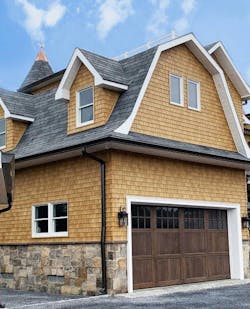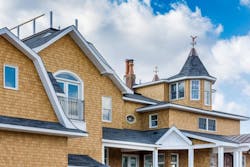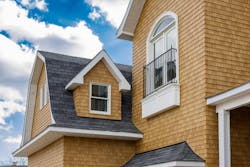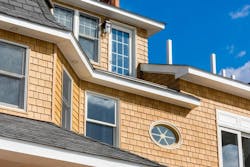Project of the Week: Polymer Siding Helps Add Storm-Resistance to a Historic Home
The siding on this water-side Dutch Colonial/Victorian looks like traditional wood cedar, but in fact the home is covered in a polymer siding to withstand the weather.
Located on the banks of Bay Shore, N.Y., the house saw enormous bay surges from Superstorm Sandy and sustained 4½ feet of ground floor flood damage. Naturally, the homeowners were reluctant to re-clad their home with cedar, which they felt was prone to deterioration and uneven weathering.
The couple approached their designer-contractor Tim White, owner of WI Development, with the idea of using it on their historic home refurbishing. Due to enormous bay surges from Superstorm Sandy, the structure had sustained 4½ feet of ground floor flood damage. As a result, the homeowners wanted a cladding to withstand the elements.
[ Read More: PROJECT OF THE WEEK: AN URBAN HOME WITH A WILD DRAGON-SCALE METAL ROOF ]
“Early in the renovation process, homeowners, Dr. Michael Sable, a local eye surgeon, and his wife Donna learned of a new type of polymer cladding—indistinguishable from cedar—but without cedar’s vulnerability to harsh weather conditions,” a project statement says. “The couple approached their designer-contractor Tim White, owner of WI Development, with the idea of using [the cladding] on their historic home refurbishing.”
Instead of wood the homeowners and their builder chose Tando’s Beach House Shake. It had a notice of approval from Miami-Dade County for high wind and high impact resistance, and because it was not wood, it would hold up well to salt spray and moisture.
Part of the Tando brand from Derby Building Products, Beach House Shake is a polymer siding that was created in response to the particular needs of contractors seeking a low-maintenance exterior that doesn’t require their customers to compromise on the authentic beauty of cedar, the company says. It is available in three shades—Hatteras gray, Pacifica Western (with the look of red cedar), and Sandcastle (the homeowner’s choice).
[ Read More: PROJECT OF THE WEEK: REPURPOSED SHIPPING CONTAINERS USED TO CREATE PREFAB UNITS ]
The home, which dates back to the World War I, features period details, a gambrel roof, and a variety of dormers, and turrets. White finds the Beach House Shake to be very conducive to the custom features of the restoration. "There are intricate cuts and angles on the home's three Victorian turrets, curved PVC trim, as well as a multitude of accents and pediments offset by a copper gable roof,” the builder says. “We have achieved 45-degree corners with the new shake, and our crew has easily shaved off 1/8 inch of material to make it fit.”
White explains that the one long panel includes several shakes, all with random patterns and dark keyways that provide a three-dimensional shadow line. It gives the installation a realistic look. “Traditional cedar requires two nails per shingle, whereas Beach House Shake includes twenty-one shingles on each panel requiring only seven nails, which can easily be installed with a nail gun,” White says.
[ Read More: PROJECT OF THE WEEK: TRANSFORMING A POOL HOUSE WITH TRADITIONAL TIMBER FRAMING ]
The builder cites other benefits for choosing the shake product. The panels are easy to cut, lightweight, and lock together to help keep out the weather. He also is mindful that there are cost efficiencies associated with the decision. Skilled labor has become increasingly scarce, and the price of shakes and shingles has increased by more than 20% as a result of U.S. tariffs on softwood lumber. As result, the traditional wood cedar installation can cost four times as much as the Beach House Shake.
Having endured Superstorm Sandy, the clients feel that their home’s exterior is more protected now with a product that is durable and hurricane-resistant, and they they have peace of mind that their treasured investment will stand tall against future weather threats.
[ Read More: PROJECT OF THE WEEK: ARCHITECT TRANSFORMS BRICK HOME WITH WOOD CLADDING]



